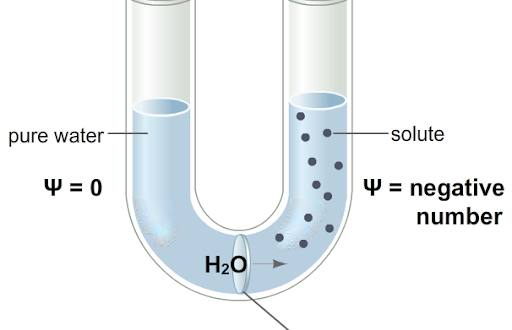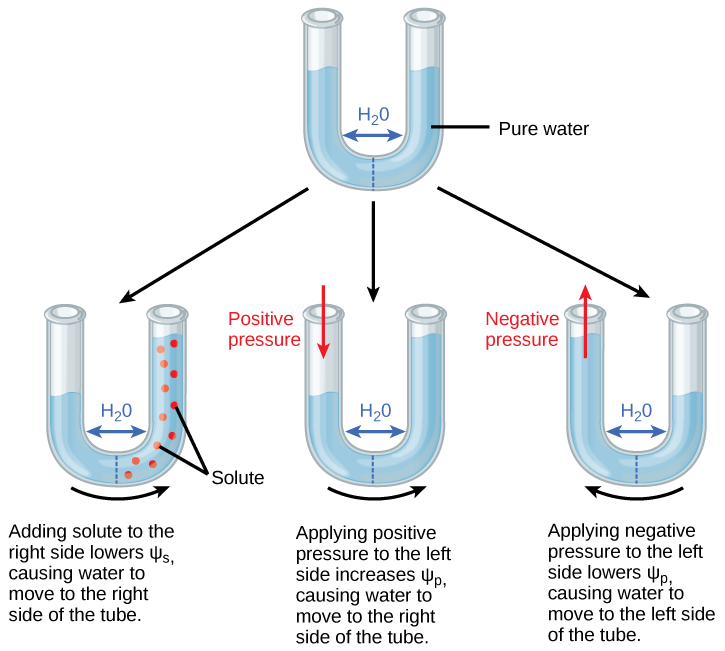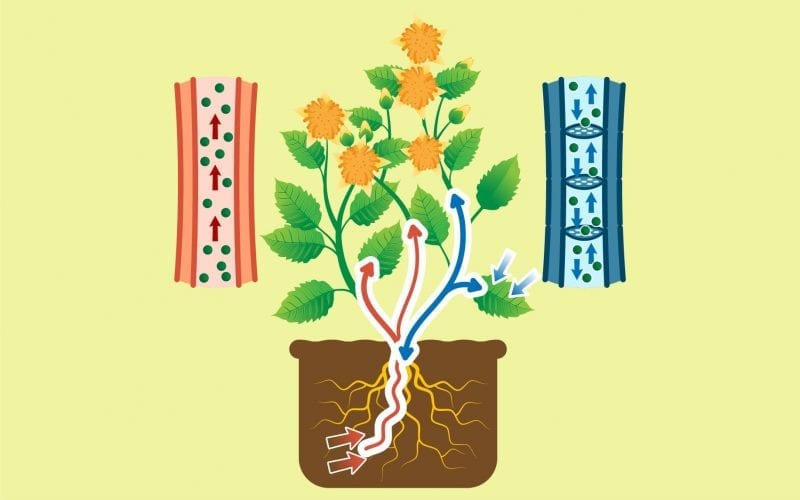The human body has a complex network of blood cells to circulate food, minerals, waste products, and gasses from one part to another. But how does this process takes place in a plant’s body? Do they also have blood vessels? The answer to these questions can be found in the biology class 11 syllabus. The chapter Transport in Plants discusses how food and minerals are transferred to all the cells and parts of the plant. Read the following notes to understand the concept better!
This Blog Includes:
- What is Transport in Plants?
- Plant- Water Relations
- Water Potential
- Transport of Water in Plants
- Osmosis
- Plasmolysis
- Imbibition
- Transportation of Food in Plants
- Physiology of the Xylem and Phloem
- Different Means of Transport in Plants
- Transpiration
- Uptake and Transport of Mineral Ions
- Phloem Transport: Flow from Source to Sink
- Transport in Plants: PPT
- Important Questions and Answers on Transport in Plants Class 11
What is Transport in Plants?
Transport in plants refers to the process of carrying water, minerals, and nutrients across various parts of the plant body. This transport includes carrying of food from leaves to other parts and the minerals and water absorbed by the other parts to the leaves, which are referred to as the kitchen of the plants.
Xylem and Phloem are the carriers that transport the necessary minerals, nutrients, etc. in the plants. Xylem is responsible for the transport of water as well as the necessary mineral salts, from the roots to various other parts of the plant, and Phloem transports the sucrose and amino acids that have been developed in the leaves to the other parts of the plant.
In other words, this unit of NCERT biology class 11 aims to help us understand how the three main parts of the plant namely: roots, stem, and leaves, connect for the supply of different things that each part is responsible for.
Also Read: Class 11 Digestion and Absorption
Plant- Water Relations
- Water provides the medium for the plants in which most substances are dissolved.
- The cells’ protoplasm is water, in which many molecules dissolve and many are suspended.
- Terrestrial plants consume a large quantity of water on a daily basis, yet the majority of it is lost to the atmosphere by transpiration.
- A mature corn plant absorbs about three liters of water per day, but a mustard plant absorbs water equal to its own weight in approximately five hours.

Water Potential
The difference between the free energy of water molecules in a pure solvent and the free energy of water molecules in a solution is referred to as water potential. The two primary components that define water potential are solute potential (Ψs) and pressure potential (Ψp). The higher the concentration of water in a system, the higher its kinetic energy or “water potential.” Water potential is represented by the Greek letter Psi or Ψ and is measured in pressure units such as pascals (Pa). At normal temperatures, pure water’s water potential is assumed to be zero. All solutions have a lower water potential than pure water; the amount of this decrease owing to solute dissolution is referred to as solute potential. For an atmospheric pressure solution, (water potential) Ψw = (solute potential) Ψs. The pressure exerted by protoplasts owing to water ingress against the stiff walls is referred to as pressure potential (Ψp). When water enters a plant cell by diffusion, causing pressure to build up against the cell wall, the cell becomes turgid, increasing the pressure potential. A cell’s water potential is influenced by both solute and pressure potential: Ψw = Ψs + Ψp.


Transport of Water in Plants
Plants need active transport of two main components namely, water from the roots and the food prepared from the leaves to the other parts. Water is transported through Xylem in plants. Xylem is a vascular tissue. It contains more than one type of cells to facilitate the process of transport within the plant system. Xylem carries the dissolved minerals and water to the leaves where, with the help of the chlorophyll, sunlight, and carbon dioxide absorbed from the atmosphere, the leaves can render their function of preparing sucrose which gives energy to the plant for survival.
Transport in plants of water starts from the roots to the stem by way of a potential gradient. The roots of the plant absorb water through apoplast or symplast, and the same is then carried to the stem for absorption by the leaves. The plants need to transport water to the leaves as water is an integral component of the process of photosynthesis. If the plants do not receive water, the process of photosynthesis cannot be completed.
Osmosis
Osmosis is the flow of molecules over a semi-permeable membrane from an area of greater concentration to a region of lower concentration until an equilibrium is established. The plant cell wall is permeable to solution and water-soluble compounds. There are two kinds of osmosis:
- Endosmosis: It is the migration of water molecules into the cell when it is immersed in a hypotonic solution.
- Exosmosis: The migration of water molecules out of a cell when it is immersed in a hypertonic solution.
Plasmolysis
Plasmolysis occurs when a plant cell is immersed in a hypertonic solution and loses water. It is determined by three sorts of solutions:
- Isotonic: Two solutions that have the same osmotic pressure across the semi-permeable membrane.
- Hypotonic: This is a solution with a lower osmotic pressure than another.
- Hypertonic: This solution has greater osmotic pressure than another.
When cells are put in a hypotonic solution, they expand or get deplasmolyzed. When cells are put in a hypertonic solution, they shrink or become plasmolyzed.
Imbibition
The process of adsorption of water molecules by hydrophilic substances is known as imbibition. Water absorption by seeds (raisins) and dry wood are two examples.
Imbibition requires a water potential gradient between the absorbent and the liquid imbibed, as well as the affinity between the adsorbant and the liquid.
Transportation of Food in Plants
In the previous part of our transport in plant notes, we observed how water is important and how it is transported. Now we will focus on another important part that needs to be equally balanced and that is the transport of food from leaves to other parts of the plant.
Food is transported in plants by Phloem, which is again avascular tissue like the Xylem. The process of transporting food or photosynthates is called translocation in Biology. Phloem contains living cells. Phloem cells are active because they need ATP for the movement of food actively. The living tendency of the Phloem cell is what is responsible for the upward movement of water by the Xylem, as it creates the potential gradient that is needed for the upward movement of water.
Also Read: Class 11 Photosynthesis in Higher Plants
Physiology of the Xylem and Phloem
For a better understanding of the chapter transport in plants, we must examine the physiology of Xylem and Phloem. The Phloem comprises two important parts called the sieve tube cells and the companion cells which help the phloem to transport food and minerals to other parts of the plant. Sieve tube members create a running chain of cells that cover the length of the plant. The companion cells run just adjacent to these sieve tube cells and they comprise the organelles and the nucleus and ribosome of these cells supplant the energy needed by the sieve tube cells to diffuse the food from one cell to another.
In Xylem the cells have to fight the very serious force of gravity to supply water upwards and the tracheids and vessel elements. Tracheids are long and thin cells and are connected from end to end. The vessel elements are wider as well as shorter as well as wonder and the end of the Tracheids contain the perforated plates and these plates allow the free flow of water. Therefore, as soon as the potential gradient is generated the water can flow freely from one cell to another and reach its final destination, which is the leaves.

Different Means of Transport in Plants
There are four major means of transport in plants and they are:
[optin-monster-shortcode id=”xf2mlnjiouddzrshykdb”]| Transport in Plant | Meaning |
| Simple Diffusion | In the process of simple diffusion, substances move from one part to another with the help of a membrane, and in this process, no help from other substances is needed. |
| Facilitated Diffusion | Facilitated diffusion is the process that is the exact opposite of simple diffusion. In facilitated diffusion, the substances move from one membrane to another with the help of other substances such as the transmembrane integral proteins. These proteins are also called carrier proteins, as they help transport. |
| Osmosis | Osmosis refers to the tendency of the fluids, in the case of plants majorly water, to be able to pass across a semipermeable membrane to a new solution where the concentration of the solution is higher than the solution of water. This equalizes the concentration of the composition of both membranes. Osmosis is how roots absorb water in plants. |
| Active Diffusion | Active diffusion is the opposite of osmosis. In the process of active diffusion, the solution with the higher concentration moves towards the solution with the lower concentration. This process happens with the help of cell energy and is often referred to as active transport. |
Transpiration
- Transpiration is the evaporative loss of water by plants, which is mostly accomplished through the stomata in the leaves.
- The exchange of oxygen and carbon dioxide in the leaf also takes place through holes known as stomata.
- The primary cause of stomatal opening or shutting is a change in the turgidity of the cells known as guard cells.
- The inner wall of each guard cell is thick and elastic, extending towards the pore or stomatal opening.
- The direction of the microfibrils in the cell walls of the guard cells also helps in stoma opening.
- When the turgidity of the two guard cells bordering each stomatal opening or hole rises, the thin outer walls bulge out, forcing the inner walls into a crescent shape.
- When the turgor of the guard cells decreases owing to water loss, the elastic inner walls revert to their original form, the guard cells become flaccid, and the stoma shuts.
- Temperature, light, humidity, and wind speed all have an impact on transpiration. Plant variables that influence transpiration include the number and distribution of stomata, the percentage of stomata that are open, the plant’s water status, canopy structure, and so on.
- The ascent of xylem sap caused by transpiration is primarily determined by the physical characteristics of water:
- Cohesion: It is the mutual attraction of water molecules.
- Adhesion: Water molecules are attracted to polar surfaces due to adhesion.
- Surface Tension: Water molecules in the liquid phase are more attracted to each other than water molecules in the gas phase.
- Water has high tensile strength and capillarity due to its physical characteristics. The capacity to withstand a pulling force is referred to as high tensile strength. The capacity to rise in tiny tubes is referred to as high capillarity.
- The tiny diameter of the tracheary components – the tracheids and vessel elements – aids capillarity in plants.
- Water diffuses into the surrounding air due to the decreased concentration of water vapor in the environment compared to the substomatal cavity and intercellular gaps, creating a ‘pull’.

Also Read: Class 11 Anatomy of Flowering Plants
Uptake and Transport of Mineral Ions
Plants’ nutritional needs are met by minerals and water for hydrogen in the soil. Because minerals are present in the soil as charged particles that cannot cross cell membranes, they cannot be passively absorbed by the roots, thus the concentration of minerals in the soil is generally lower than the concentration of minerals in the root. The majority of minerals must reach the root through active absorption into the cytoplasm of epidermal cells, which require energy in the form of ATP. Ions from the soil are actively pumped into the cytoplasms of epidermal cells by specific proteins in the membranes of root hair cells.
Endodermal cell transport proteins act as control points, allowing a plant to regulate the amount and kind of solutes that reach the xylem. Because of the layer of suberin, the root endodermis may actively transport ions in only one way. After the ions reach the xylem, they are transported up the stem to all sections of the plant through the transpiration stream. Mineral ions are unloaded at the fine vein ends by diffusion and active absorption by these cells. Mineral ions are often remobilized, especially in older, senescing portions.
Phloem Transport: Flow from Source to Sink
Sucrose is carried from a source to a sink via the vascular tissue phloem. The source is the location where food is synthesized, i.e. the leaf, and the sink is the location where food is required or stored. Because the source-sink connection is changeable, the direction of flow in the phloem can be either upwards or downwards, i.e., bi-directional, as opposed to the xylem, which is always unidirectional, i.e., upwards. Food in phloem sap can be delivered in any direction necessary. Water and sucrose are carried via phloem sap, but other sugars, hormones, and amino acids are also transported or translocated by phloem.
Transport in Plants: PPT
Important Questions and Answers on Transport in Plants Class 11
Most of the plant cells are dead and do not have any kind of energy in them. Therefore, their energy needs are also relatively slow. This is the reason why transport in plants is slow, as they do not need high pace transportation as is needed in the body systems of animals because they have more active and living cells than the plants.
This chapter on transport in plants is extremely important because it helps in understanding the flow of necessary elements such as minerals, proteins, sucrose, water, nutrients, etc., between various parts of the plant. Without the transport, the plant will not survive, as the different units will not be able to perform the functions that are needed for the proper functioning of the plants. The survival of the plant depends on the active transport in the plants. You must have observed that many times when there is wear and tear in the body of the plant, the plant dies. This is because the process of transport is interrupted because of wear and tear. Any change in the physiology of the plant affects its transport mechanism.
Porins are proteins that create huge holes in the outer membranes of plastids including chloroplasts, mitochondria, and certain bacteria, allowing for the passive transport of small-sized protein molecules. As a result, porins aid in diffusion.
Active transport is the application of energy to move molecules against a concentration gradient. Active transport is carried out by membranes, which play an important role in both active and passive transport. Pump proteins use energy to transport molecules across the cell membrane. These pumps may move chemicals from a low concentration to a high concentration (referred to as ‘uphill’ transport). For example, H+ pumps, K+ pumps, Cl- pumps, and Na+-K pumps. The pumps work with the assistance of ATP. Guard cells have a K+-H+ exchange pump. The Na+-K+ exchange pump is found in many animal membranes. When all of the protein transporters or pumps are utilized or are saturated, the transport rate hits a maximum. Like enzymes, these carrier proteins are very specific in what they carry across the membrane. These proteins are sensitive to inhibitors that react with protein side chains.
The molecules of water have kinetic energy. They are in random motion in liquid and gaseous forms, which are both fast and continuous. The higher the concentration of water in a system, the higher its kinetic energy or “water potential.” As a result, it stands to reason that pure water will have the maximum water potential. Water potential is represented by the Greek letter Psi or and is measured in pressure units such as pascals (Pa). By convention, the water potential of pure water at normal temperatures and no pressure is assumed to be zero. When a solute is dissolved in pure water, the solution contains less free water, and the concentration of water drops, lowering the solution’s water potential. Hence, all solutions have a lower water potential than pure water.
When pure water or a solution is subjected to pressures greater than atmospheric pressure, its water potential increases. It is analogous to pumping water from one location to another. Pressure can build up in a plant system when water enters a plant cell via diffusion, causing pressure to build up against the cell wall, leading the cell to become turgid.
We hope that through these pointers on transport in plants, you are now familiar with this important topic. Our experts at Leverage Edu are here to help you get started on the right career path without any hassle. To know more you can book a free career guidance sessions with our experts.

 One app for all your study abroad needs
One app for all your study abroad needs





















 45,000+ students realised their study abroad dream with us. Take the first step today.
45,000+ students realised their study abroad dream with us. Take the first step today.

